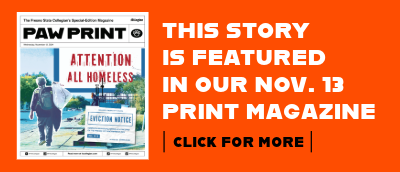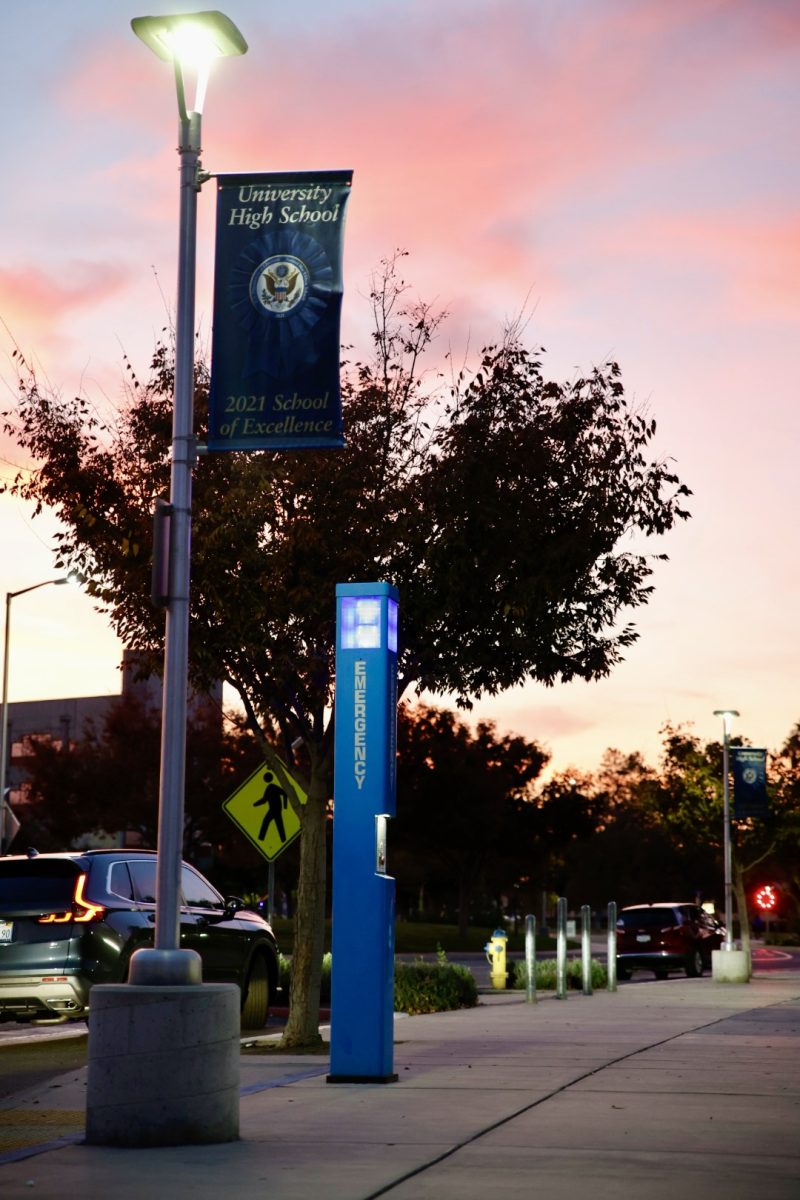Despite Fresno State’s blue light emergency poles being designed to assist with on-campus safety, their effectiveness has been called into question by students on campus.
“When I come out of my night classes that end around 9 p.m., I don’t feel as safe because it’s lacking the human safety net during the day,” said Kaitlyn Williams, a communications major at Fresno State. “Buildings like Science II make me feel a little more unsafe, because of how dark they are inside.”
The emergency phones were installed at Fresno State in 2003, but at the time of their introduction, they were yellow. The blue emergency phones replaced the yellow ones during the 2016-17 school year.
The emergency phones are supposed to make direct calls to the Fresno State Police Department dispatchers, according to Lisa Bell, the public information officer at Fresno State.
There are currently 78 exterior blue light emergency phones on campus. Thirteen of those exterior phones are non-operational, but only 8 have bags over them as of Nov. 6, indicating that they can’t be used. The university did not disclose what the situation is with the other five.
“The Police Department tests each emergency phone once a month for audio quality and to make sure the lights blink when the phone is activated,” Bell said.
She also said that if the phones have any issues, the police department will work very closely with technology services and facilities management to get them repaired.
“We are diligently working to mitigate the communication issues with these devices,” Bell said.
Other colleges have had similar issues with the emergency blue lights on campus not working. Sacramento State’s student-run newspaper, The State Hornet, wrote an article last year on how seven of the campus phones were not operating correctly.
As a result of the lights not working on the university campus, women at Sacramento State felt unsafe, especially with two cases in 2022 of sexual assault.
How Safe Do Students Feel?
In the 2023 Annual Safety Report, the Fresno State Police Department detailed campus crime statistics, revealing that 13 cases of stalking were reported during the year.
Bianca Gonzalez, a broadcast journalism major, expressed concerns about campus safety. While leaving work, Gonzalez had a frightening encounter with a stranger that left her feeling unsafe on campus.
“Recently, I was followed while on campus — it’s still kind of fresh and new,” Gonzalez said.
As one of the last to leave the building, she noticed a man walking toward her as she headed to her car, though she didn’t think anything of it at first due to the daylight.
“I was on the phone with a friend, so at this point, I didn’t really have a reason to be worried,” Gonzalez said. “But the thing is, that parking lot was empty and there isn’t really a reason for anyone to be there after hours.”
Luckily, she managed to get into her car and lock the doors safely.
Some students remain skeptical about the effectiveness of on-campus safety measures.
“I definitely appreciate that we have the blue lights on campus, but I would definitely feel safer if they added more in the areas where they are spread thin,” said Jesse Shelbourne, an agriculture major.
She added that safety is a top priority for her since certain areas on campus are not as bright at night as other parts, such as parking lots like P20 and P1.
“When it comes to safety, I tend to avoid having classes after 5 p.m. because of the sun setting,” said Samantha Zendejas, a psychology major.
She mentioned that even if she avoids those later classes, she still feels some security knowing the blue lights are there.
“I feel that having these lights present, even if they are not being used, brings students peace and a sort of security in knowing we have those poles in almost every corner,” Zendejas said.
However, not every student is aware of the emergency lights on campus.
“I’m going to be honest, I don’t remember ever seeing one of the blue lights when I walk around, so I don’t think they’re that visible or accessible,” said Williams.
What On-Campus Safety Resources Does Fresno State Offer VS. Other Universities?
Students have access to other avenues of safety on campus, including the anonymous tip reporting line, on-campus safety programs and the Rape Aggression Defense System (R.A.D.) training for women.
“Unfortunately for women specifically, feeling unsafe at night is just something that we kind of expect, which is sad. We shouldn’t have to expect it,” Gonzalez said.
Fresno State PD advises students to avoid walking alone at night, stay aware of their surroundings and trust their instincts.
To get past the issues, some colleges like Arizona State University have found ways to improve these lights and use them for other operations.
ASU News reported on how they use the blue lights to help make their campus a safer environment for students, staff and faculty.
Their blue light emergency poles are equipped with self-monitoring, analysis and reporting technology (SMART) devices, which have sunlight and temperature sensors that monitor human activity across campus, considering factors such as building location, cars and pedestrians, landscaping and more.
“One example that surfaced was combining the data from the sensors to inform a more environmentally friendly campus design that would ultimately improve the services and experiences of the community,” said editorial specialist Tristan Ettleman.
If implemented at Fresno State, the data collected by the emergency light sensors could benefit safety on campus, making it possible for Traffic Operations at Fresno State PD to create smarter environments for cars and pedestrians.
For more information about the emergency phones, contact Fresno State’s Department of Public Safety at 559.278.8400.





